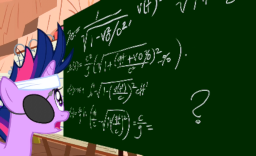
On Couple Moments
Twilight Sparkle Gives a Vector Mechanics Lecture
Twilight turned to face the ponies gathered in the auditorium of city hall. “Thank you all for coming, not that you had a choice. It’s a miracle that nopony was killed in that skyscraper collapse. Not to mention the thousands of bits in materials and pony-hours that were wasted.”
A dozen blank faces looked back at her over as many opened texts and blank notebooks.
She made eye contact with each one in turn, then continued. “We can’t have another incident like that. I’ve looked over your ‘calculations,’ if we can even call them that, and they are—” she narrowed her eyes “—insufficient.”
A shaggy stallion in a curled baseball cap raised one foreleg into the air. Twilight smiled and pointed at him, saying, “Yes, a question? What’s your name?”
He lifted the brim of his hat to push it to the back of his head and drawled, “I’m Sun Ray. Why do we need to learn this stuff?”
She looked at him and blinked. “Because you need to do a proper static analysis in order to safely design a structure.”
He waved a leg in the general direction of outside. “But Ponyville is all straw roofs and stucco-covered wood beams. We never needed to do calculations before.”
“But you weren’t trying to build a wood-framed house with a straw roof.”
“So?”
Twilight simply smiled and nodded, then used her magic to pick up one of the six full and pristine pieces of chalk under the blackboard, and drew a quick sketch of a cube with several arrows sticking out of its center. “You have considered the sum of forces acting on each component, but—” she paused while reworking the sketch into a long beam, with a downward arrow on one end and an upward arrow on the other end “—you have failed to consider the moment induced by those forces.”
She turned around just in time to see a stallion in the back row elbow a mare and whisper loud enough for the whole class to hear, “If you have to force a moment, you’re doing it wrong, heheh.” The mare rolled her eyes and scooted her chair a few inches away.
Twilight cleared her throat and said, “You’ve covered static equilibrium of point particles, but you also need to consider ‘moments,’ which you may better know as ‘torque.’
“We can’t always assume each body can be treated as a particle. In fact, most objects have enough size that forces act at different points on the body. However, we will assume that the bodies themselves are rigid; the points that make up, say, a beam, are held in fixed locations relative to each other. What we are concerned about is the moment about a point and moment about an axis. We define a couple as two forces of equal magnitude, opposite sense, and parallel. The net force due to a couple is by definition zero.”
She turned to face the class, chalk still held up to the last shorthoof note on the board. They were all scribbling furiously on their notes. She nodded with a quiet grunt, and turned back to the board.
“We also have to clarify that external forces are the action of other bodies on the rigid body we’re considering, and internal forces as forces which hold a rigid body together. We’re going to ignore these until chapter six. Let’s look at the external forces acting on a cart being pulled by a rope.” She sketched a simple rectangle with a pair of circles underneath, and a single straight line extending to the right.
The chalk clattered rapidly as she drew a series of arrows coming from various points on the cart. “We have several forces acting on the cart here. The weight of the cart acting at the center of gravity. The ground pushing up on the wheels, which we call reaction forces R_1 and R_2. The force of pulling forward on the rope causes the cart to roll forward, which we call translation. If instead we put a jack under the front bumper, it causes the cart to rotate about the rear wheel, which is obviously called rotation. To sum up, the forces acting on a rigid body can cause translation, rotation, or both.” She turned to face the class and smiled. “If unopposed, of course.” She giggled, having clarified something so obvious that nopony needed to write it down. Then she frowned as she noticed that everypony was writing it down anyway. With a sigh, she turned back to the board and resumed writing.
“The principle of transmissibility tells us that the conditions of equilibrium remain unchanged if a force F acting at a given point is replaced by a force F' of the same magnitude and direction, but acting at a different point, if both forces have the same line of action. These forces are therefore equivalent. So, a force may be transmitted along its line of action, maintaining equivalence. In other words, we can slide the pulling force on the truck to the rear as a pushing force, with the same result.”
Twilight watched as they set down their pencils and looked up, one by one. Their wide eyes and twitching ears told of the panic rising in the back of their throats. Of course, she needed to hurry up and get to the math. Everything’s easier to understand when explained with math.
A pegasus stallion in the middle of the classroom looked at all of his silent classmates, then broke the silence. “Rrraaaauuuugh!”
The chalk sagged in Twilight’s distracted magic as she pursed her lips in confusion. One of the other stallions said, “You’ll get used to Patent Fringe, but we just call him ‘the pegasus.’”
The pegasus adjusted his knit hat and added, “I could sing show tunes if you’d prefer.”
“I…” Twilight turned around and started writing on the board again. “For the next part, we have to define a vector product. We want to multiply two vectors, and have a vector as a result. The vector product \overrightarrow{V} of vectors \overrightarrow{P} and \overrightarrow{Q} is perpendicular to both, ergo perpendicular to the plane PQ. The magnitude of the vector \overrightarrow{V} is then V = PQ \sin (\theta) and the direction comes from the ‘right-leg rule.’ Those of us without wings may have to sit down to do this with our front legs and head. Point your right foreleg along \overrightarrow{P}, then bend in the direction of \overrightarrow{Q}, and the top of your head points in the direction of \overrightarrow{V}. You’re going to end up looking like a sommelier without a towel.” She held her foreleg in front of her and waited for the other ponies to look impressed.
“Some of what?”
Twilight sighed and spoke in a monotone as her ears lay flat along the back of her head. “A fancy waiter.”
A wave of comprehension washed over the crowd before they all turned to each other and pretended to speak in terrible accents and take each others’ orders. Twilight liberally applied hoof to face, then slowly shuffled back around to the chalkboard and drew the next diagram. As the conversation died down, she heard the voice of the pegasus declare, “You smell nice.” She sighed again before continuing.
“First, we have to redraw \overrightarrow{P} and \overrightarrow{Q} to have same point of action. These three vectors \overrightarrow{P}, \overrightarrow{Q}, and \overrightarrow{V} then form a right-hoofed triad. Which is why we chose our x, y, and z axes to point to the right, up, and out of the board, respectively. The vector product is then: \overrightarrow{V} = \overrightarrow{P} \times \overrightarrow{Q}. Which we also call a ‘cross product.’” She leaned back and grinned at the class. “Because we use the big X like we’re going back to grade school.
“If the vectors are in the same, or opposite, directions, then, because the angle between them is either zero or one-hundred-eighty degrees, the vector product is zero—”
“Your mom’s vector product is zero!”
Twilight froze with the chalk still touching the board. Without turning around, she asked, “Who said that?”
When nopony responded, she turned around and glared at the class. “I’m not angry about the ‘your mom’ joke. Honestly. It’s just not funny. I mean, if it was in reference to two vectors lying in a plane, you might possibly make it funny, but it would take a lot of work. If you absolutely must disrupt class for a joke, at least make it a funny joke.” Her ears perked up and she dropped the chalk haphazardly onto the tray. “Like this one.”
Two or three of the ponies halfway smiled, while the rest groaned or rolled their eyes. Twilight licked her lips. “What do you get when you cross a mosquito with a mountaineer?”
Nopony responded.
Twilight grinned and leaned forward. “Nothing! You can’t cross a vector and a scalar!”
The makeshift classroom was filled with raucous laughter, but all of it was coming from the convulsing unicorn at the front of the class. After settling her breathing and wiping the tears from the corner of her eyes, she said, “Oh, come on, that was a good one! Nobody? Okay then, let’s continue with the lecture.”
As soon as she turned around, several voices called out simultaneously.
“Two stallions walk into a bar…”
“Knock knock…”
“Have you heard the one about…”
“There once was a filly from…”
Twilight stomped hard enough to rattle the pencils on every desk. “New rule. No jokes. Moving on. Note that \overrightarrow{P} \times \overrightarrow{Q} = -(\overrightarrow{Q} \times \overrightarrow{P}) which means that the commutative property is NOT valid. However, \overrightarrow{P} \times (\overrightarrow{Q}_1 + \overrightarrow{Q}_2) = \overrightarrow{P} \times \overrightarrow{Q}_1 + \overrightarrow{P} \times \overrightarrow{Q}_2 which means that the distributive property is in fact valid. Again however,” she chuckled again to herself, “\overrightarrow{P} \times (\overrightarrow{Q} \times \overrightarrow{S}) \neq (\overrightarrow{P} \times \overrightarrow{Q}) \times \overrightarrow{S} the associative property does not hold true.”
Moving to the other end of the chalkboard, Twilight began drawing a few examples on the board, using her projected three-dimensional axes. “Can somepony tell me in which direction is the cross product of these two vectors \overrightarrow{A} and \overrightarrow{B}?”
“I got it!” Twilight turned around to see Sun Ray lying sideways on his desk, curling his left leg in what looked like a very uncomfortable direction. “Is it this way?”
Twilight had the sudden feeling that today was going to be a multiple-facehoof day. “Sun Ray, no, it’s the ‘right-leg rule.’ No… Your other leg. Yes, that one.”
He flopped both of his forelegs back onto the desk and whined, “But Miss Sparkle, I’m left-hoofed. Can’t I just use my left leg and then switch the directions?”
“No, because you’re more likely to make a mistake, probably when you forget to reverse the direction.”
“But what if I never forget?”
She huffed before saying, “That is unlikely. Right-leg rule.” She turned back to the board and pointed to the next pair of arrows. “And the direction of this one?”
She was hoping to hear a clever pony shout out, “The positive k-hat direction!” However, what she actually heard was the sound of chairs and desks sliding. Upon turning around, she witnessed a dozen mares and stallions bending over backwards or standing on their hind legs and twirling around, contorting their forelegs in improbable directions more appropriate for four-dimensional tensors than three-dimensional vectors.
It was like some sort of interpretive dance invented by Discord and choreographed by the Cutie Mark Crusaders. It was at once terrible and beautiful. She had to end it.
“Stop! Look at me.” She faced the board. “Point your right leg along vector \overrightarrow{A}. Now, see how I have to lean back to curl my leg in the direction of vector \overrightarrow{B}? Now my head is pointing along the positive z-axis. See how simple that was?”
Sun Ray raised his hoof, but didn’t wait for Twilight to acknowledge him. “I got the right answer with my left leg. I’m gonna use the left-leg rule on my homework.”
“I…” Twilight began, then sighed. “I stopped caring. I offer no mercy on grading when you get the answer wrong.” Her eyes were mere slits as she glared at the rest of the students. “No. Mercy.”
Several ponies switched to their right legs. Twilight turned around again, and picked up a new, perfectly cylindrical, piece of chalk.
“The vector product of a vector with itself is zero, since both are in same direction. We can express the vector product \overrightarrow{V} in terms of components like so: \overrightarrow{V} = \overrightarrow{P} \times \overrightarrow{Q} = (P_x \hat{i} + P_y \hat{j} + P_z \hat{k}) \times (Q_x \hat{i} + Q_y \hat{j} + Q_z \hat{k}). And by distributing after the cross product, we can put it in component form like so: \overrightarrow{V} = (P_y Q_z - P_z Q_y) \hat{i} + (P_z Q_x - P_x Q_z) \hat{j} + (P_x Q_y - P_y Q_x) \hat{k}. The rectangular components of this vector would be…” She wrote the next three equations in a rectangular arrangement of rows and columns.
\begin{matrix}
V_x = P_y Q_z - P_z Q_y \\
V_y = P_z Q_x - P_x Q_z \\
V_z = P_x Q_y - P_y Q_x
\end{matrix}Twilight stood back and heaved a satisfied breath, then turned to look at the class. She was met with a few dozen blank stares. “Nopony? It’s a matrix! And if we write it like this—” she scribbled again on the board “—we can use the determinant to find the cross product!”
\overrightarrow{V} = \begin{vmatrix}
\hat{i} & \hat{j} & \hat{k} \\
P_x & P_y & P_z \\
Q_x & Q_y & Q_z
\end{vmatrix}She beamed across the classroom triumphantly. One stallion in the back halfheartedly gave a flat, “Yaaaaaaay.” The rest of the class chuckled.
Twilight turned back to the board, but paused as the pegasus roared again. “Okaaaay, now we can actually calculate a moment. We have a force F acting on a rigid body, and its effect depends on its point of application A. We’ll define the position of A by a vector \overrightarrow{r} which goes from a fixed reference point O at the origin to A. This is the position vector of A. These two vectors, \overrightarrow{F} and \overrightarrow{r} define a plane. The moment of \overrightarrow{F} about O is the vector product of \overrightarrow{r} and \overrightarrow{F}: \overrightarrow{M}_O = \overrightarrow{r} \times \overrightarrow{F}.
“The sense of this vector is defined as rotating in the direction to bring the first vector toward the second. Point your longest primary feather along the axis of rotation, and the moment causes a spin in direction of your curled feathers. We’ll define the angle between the lines of action of \overrightarrow{r} and \overrightarrow{F}, so then the magnitude of the moment vector is given by M_O = rF \sin(\theta) = Fd where d is the perpendicular distance between O and the line of action of \overrightarrow{F}.”
“Your mom is perpendicular betwee—”
The joke was interrupted by an icy knife-like glare that Twilight whipped over her shoulder. After an appropriately scolding moment, she turned back to the board. Before she could resume her lecture, the pegasus said, “Boy, that was awkward.” This caused the class to dissolve into snickers and giggles.
Twilight closed her eyes, took a deep breath, thought about math, and pressed on. “The magnitude of this moment vector is the tendency of \overrightarrow{F} to make a rigid body rotate about the fixed point O around an axis along the direction of the moment vector. The moment vector completely defines the line of action of \overrightarrow{F} of a given magnitude and direction. We define equivalent forces by saying that two forces are equivalent if and only if they have the same magnitude and direction, and provide equal moments about any given point O.”
Twilight tossed the chalk up into the air, spun around and caught the chalk in her magic again. She danced on her hooftips, and said, “We’re getting to the exciting part!”
“The moment about O of the resultant of several concurrent forces is the sum of the moments of the individual forces about O: \overrightarrow{r} \times (\overrightarrow{F}_1 + \overrightarrow{F}_2 + \dots) = \overrightarrow{r} \times \overrightarrow{F}_1 + \overrightarrow{r} \times \overrightarrow{F}_2 + \dots. Which means we can also break up a force into its rectangular components. We can do this either parallel to our axes, or not, depending on which is easier.
“Now, the components of the position vector \overrightarrow{r} of point A are equal to the rectangular coordinates of A. So the moment \overrightarrow{M} about point O due to force \overrightarrow{F} acting at point A is,” and she wrote another matrix on the board:
\overrightarrow{M}_O = \begin{vmatrix}
\hat{i} & \hat{j} & \hat{k} \\
x & y & z \\
F_x & F_y & F_z
\end{vmatrix}“But,” she said and wiggled her backside, “and this is a big but, we can draw the vector from point B to point A instead of from the origin, using \overrightarrow{r}_{A/B} as the position vector \overrightarrow{r} of A relative to B.”
The pegasus said, “Whoa.”
“Aaaand getting back to couples, we’ve got those two forces with the same magnitude, parallel lines of action, and opposite sense. The sum of forces from a couple in any direction is zero. Ergo, any body acted upon by a couple—”
“Your mom is acted—”
Twilight threw the chalk backwards over her shoulder, not bothering to aim it at any pony in particular, and smoothly picked up the next piece of chalk before hearing the first piece shatter against a piece of furniture, and continued smoothly with her lecture “—will NOT translate. The points of application of forces \overrightarrow{F} and -\overrightarrow{F} are \overrightarrow{r}_A and \overrightarrow{r}_B relative to origin O: \overrightarrow{r}_A \times \overrightarrow{F} + \overrightarrow{r}_B \times (-\overrightarrow{F}) = (\overrightarrow{r}_A - \overrightarrow{r}_B) \times \overrightarrow{F}. So we define \overrightarrow{r}_{A/B} = \overrightarrow{r}_A - \overrightarrow{r}_b as the position vector from B to A then we can define the moment about O as \overrightarrow{M} = \overrightarrow{r} \times \overrightarrow{F}.
“The magnitude of the moment of the couple is then M = rF \sin(\theta) = Fd where d is the perpendicular distance between \overrightarrow{F} and -\overrightarrow{F}. Again, the sense of \overrightarrow{M} is defined by the right-leg rule. Interestingly enough, the vector \overrightarrow{r} is independent of the location of O, so the moment is the same about any point O or O’. Which means that the moment of a couple is a free vector; it can be applied anywhere!” Twilight squealed, genuinely delighted at the mathematical proof she had just delivered.
The pegasus raised a hoof. Twilight’s smile faded away as her eyelids began to narrow. He tentatively said, “Your mom… and your dad are a free couple, who can have a moment anywhere.” He raised one eyebrow and tilted his head toward Twilight, waiting for her to respond.
Sun Ray threw his notebook in the air with both hooves, sending loose papers fluttering down all around the classroom as he turned around to look at the pegasus. “Pat! Celestia, what in tartarus was that?”
Twilight gritted her teeth and growled as she turned back to the chalkboard for the final time. “Two couples \overrightarrow{F}_1 / -\overrightarrow{F}_1 and \overrightarrow{F}_2 / -\overrightarrow{F}_2 will have the same moments if F_1 d_1 = F_2 d_2, no matter where they are located, as long as the couples lie in parallel planes.”
Twilight rested the chalk in the tray and looked back over the class. “Any questions?”
Sun Ray raised a hoof. When he didn’t speak for several seconds, Twilight sat on her haunches and rubbed her temple with one hoof, pointing toward him with the other. “So, why do we need to know all this stuff again?”
























I now realize the biggest flaw with my physics class. My professor isn't a purple unicorn.
5145718
Clearly, a major with modern education systems. The lack of fc09.deviantart.net/fs70/f/2014/014/c/3/fitwi_by_comeha-d7252jt.png
Oh, that was great.
College is fun, yo.
5149132 Thanks! It's fun on both sides of the lectern!
Ah yes, vector calculus! Sadly, I only ever learned the math, not what it was actually used for. Automatic upvote for math, but a lot of your images seem funky and not lined up with the text properly.
I'm really tempted to write "Twilight Teaches You Calculus Backwards" now.
5149384
Not possible to correct without actually embedding the text of the entire paragraph into the image or FiM Fiction allowing finer control of formatting. Both approaches cause problems.
5149458 That is true. I did what I could with the images. I'd like a way to vertically center them relative to the text, but that's actually a lot to ask, and most stories don't require inline images (or math equation rendering, for that matter).
5149485
5149458
Really? I've been embedding images into my text without much problem. I suppose it's difficult if the text is abnormally tall, though. Then again, I was also using SVGs to render the text natively, which works sometimes, but occasionally there's a font mismatch. Still, to me, it seemed like there was much more of an alignment problem than there really needed to be.
If I had just read this story in my first year I would have been better at linear algebra... and subsequently my vector calculus course. If only there was a whole series dedicated to teaching mathematics with ponies, *hint* *hint*
Another reason why PurpleSmart is best pony! Great story, Hap!
5149734 Thanks!
Well Vector Mechanics are interesting...
I think I'll wait for the abridged version I'll likely get my junior high school year, or senior depending upon a few factors
I liked it because of the vector and scalar joke, is funny because it works on more then one level.
5154729 I like to think it's a joke that has... three dimensions!
Okay, that one was really bad. Sorry.
Sorry.
And no, I didn't invent the joke. I work with a lot of math teachers.
5149384
Not just the centering, it doesn't work well with the dark backgrounds.
5166157 True. Let's lobby Knighty for rendering support for MathType.
Unfortunately, I majored in Arts & Technology (or Emerging Media; I switched majors a lot). So a lot of this sailed right over my head. Been a while since I was in a math class, now that I think of it.
Got the Scaler and Vector joke, though.
I didn't understand any of that math.
But, it was well written, got some chuckles from me, and I learned a new joke. And, if I ever need to build a wooden skyscraper ... I'll hire an actual engineer.
I expected Purple Smart not to limit herself to such a pedestrian special case as three-space. At least not without apologising profusely for the loss of generality
This story reminds me about a conversation I had a while ago about τ (Tau). As everypony knows, the 1 true CircleConstant is τ which is c/r. The use of τ/2 is an historical accident. The biggest proponents of τ/2 are engineers who use calipers for measuring crosssections. The could also could get the most benefit from τ:
Engineers like to use π (Pi) for τ/2 The formula for the area of a circle written in terms of π is:
πr^2
When they have to figure out the volume of a sphere, some disastrously use the formula:
πr^3
Or
¾πr^3
These mistakes are from using the wrong CircleConstant. The generic formula is:
(d-1)/dτ^d
D is dimention. In 2D, it is:
(2-2)/2τr^2
This simplfies to:
½τr^2
In 3D, it is:
(3-1)/3τr^3
This simplifies to:
⅔τr^3
¡It is impossible to mess up the mathematics if one uses the 1 true CircleConstant!
5176773 Does that work in dozenal as well?
5178770
You know perfectly well it works in duodecimal, or any base. Somewhat seriously, this raises the question what is a good base to give the ponies in our stories:
One might as well make the ponies more alien by giving them another base. The most obvious accidental base for ponies is quaternary because ponies have 4 hooves. enough said about Quaternary.
By radix-economy, the best integer base is ternary. Mathematically, the best form of ternary is balanced ternary. One uses -1, 0, and +1, Let us represent these as T, 0, and 1. τ is:
τ = 1T0 . 10T,T0T,110 , 0T1,10T,T0T , 1TT,000,001
I did the conversion myself.
It has the lowest carry-rate of only 2/9ths. One carries ¼ of the time in binary and 9/20ths of the time in decimal.
Truncation and rounding is the same operation.
Arithmetic is simplest in balanced ternary.
If we have our fictional ponies use something else than quaternary or balanced ternary, some bases are better than others. Bases which immediately come to mind are highly composite numbers and greatest common multiples of natural numbers up to a certain value:
Highly composite numbers have many factors.
Least common multiples of natural numbers up to a certain value allow for lots of consecutive low divisors. Least common multiples are highly composite up to 60. This points to sexagesimal. Sexagesimal is a good base for fictional ponies.
PHYSICS!
I THINK!
MOST DEFINITELY MATH!
imma go bash my head into a wall now......
5210358 Physics... on steroids. Well, the first part of the first semester of Physics, anyway.
5210825
 the one part of science i hate with a passion
the one part of science i hate with a passion
physics....
5210901 Them's fightin' words.
I always knew "The Mysterious Mare-Do-Well" had a lot more to say about competent civil engineering and city planning than about bragging, but I somehow never even considered how ponies would apply the right-hand rule. I really appreciate my hands.
Remind me to bring my vector calculus questions to you.
5406876 Sure!
It bothers me that I don't understand more of the math. It's been way too many years, and it's in the wrong language.
I'm guessing that this is college-level math? Most of it seems to be the same as in the advanced math classes I took, but since I never went to a college-equivalent or university I never got to use it enough to remember much.
Nice variation on the right hand rule. Statics wise, it would have been better to introduce them to 2d stuff first, no cross products that way.
5423997 a fair amount of this is easier to digest with visual aides. Yeah its college level. My introduction to vector math was in first quarter physics, you see it alot in engineering.
5423997 Yes, as jxj said, it's a college level engineering class called "Vector Mechanics for Engineers" aka "Statics." I've actually had readers who were taking this course as they read this story, and identified the book from the lecture that Twilight presents, which is pretty much copy/pasted from my lecture notes, with added dialogue and interaction with students.
5424711
5425332
I am terrified of going into mechanical engineering now... maybe I should stick with programming... I'm so terrified and I didn't even read the whole story yet.
How close does Mutlivariable Calculus and Differential equations come to this at least in terms of difficulty or when you learn it?
So despite being in arguably the best magnet program in my school county, I have still no understanding of physics... I should have taken AP Physics C this year... it's Senior year. I mean even if I bombed the AP test, I would be so much more prepared for taking physics in college.
I have so much to learn. I'm terrified that I won't be able to stand engineering as a career.
6612900 it's not as bad as it seems. As it turns out, fanfics aren't the best way to convey knowledge of statics and i've never been good at learning math from textbooks. Multi variable calculus isn't to bad. To quote my physics professor "stuff in 3d is the same as in 1d, just thee times the fun." That's essentially true For example the multi variable equivalent of the derivative is the gradient and is the derivative with respect to each variable. Differential equations range drastically in difficulty. you might have seen them already. v=dx/dt is a really simple differential equation. Multivariable calculus is typically the last calculus class you take (at least in the U.S.) and differential equations is typically after that along with some linear algebra (really useful stuff). I'm a junior (third year) and i'm still waiting for the ball to drop on math, although that's going to happen any day now.
For mechanical engineering, you'll need a strong grasp on classical mechanics. Although with the way it's structured (at least in the U.S.) You'll end up taking a basic physics class that will introduce you to basic mechanics. Then you'll take classes that cover portions of mechanics in much greater detail. It'as also useful if you can visualize parts and see how they interact in your head.
I wouldn't worry to much about taking the AP classes as long as you took the basic physics class and understood what was going on. I grew up in a small town. You mentioned being in the best program in your county, I went to the only high school in the county. One AP test in English. Now i'm going to a very had to get into school (under 10% acceptance rate) and one of the best ME programs in the state.
6613250 Congratulations on getting in!
5425332
I also neglected to mention that I am taking Multivariable Calc right now, and Differential equations next semester. So. It's this easy? Calculus wise anyway. I'll probably have to take it again in college just to help me remember, because I don't memorize this stuff, but it will be that much easier.
Thanks
6613712 I wouldn't say the class is easy, for sure. But it really, really builds on what you learn in General Physics I. Which, don't worry about not having a physics class in high school. You'll have to un-learn it all anyway, to make room for the more rigorous Gen Phys.
So, if you don't understand it now, don't worry. That's to be expected. Also, I wrote it not to convey the material, but to be funny. The way the material is presented in this story is intended to highlight the divide between Twilight and the students. She's as naive and clueless as they are, but in a different way.
Also, it's not the calculus you need to worry about. It's the trig. You'd better really fuckin' love triangles.
6613712 multivariable isn't to bad until the very end. The main problem with differential equations is that there isn't a set way to solve them. If it meets certain criteria, you can solve it one way, but if it doesn't then you can't. The point of me mentioning my school is that you don't need to go into college with a lot of AP math and trig.
Like Hap said, the class isn't easy even if the math isn't super intense compared to what you get in math classes. The hardest part will also probably be the massive slog of algebra and trig. I ended up with a system of 24 equations (without any knowledge of linear algebra). I spent 5 minutes or so generating them using statics, and I ran out of time trying to solve them with algebra.
6613939 Well I took AP Phyiscs A and II (because I happened to take AP Physics A the year before they changed it to I and II, and now they are 2 different tests too. It used to be that you had to take AP Physics A one year and then B another year, and then take 1 test for both.)
It's just that AP Physics I and II aren't worth very much to most colleges or anywhere near as Rigorous as AP Physics C. On the other hand, AP Physics C would probably have overwhelmed me now... Then again it will probably overwhelm me a bit in college too, plus I'll be taking harder courses in college on top of that... Oh well, I'll live.
I'm just worried because I'm working on deciding part of my future right now, and I'm not exactly sure what I want or need. That's what college is for though. I said that I was terrified not so much because it will be hard (because anything I want to do will be hard, and worth it), but because I'm not sure if I can stand doing so many equations and math all the time in a career. Well it depends on exactly what jobs I take, and even then, I shouldn't ever have a job where I do math most of the day. I hope. Math's not bad, it just takes a while to go through all the steps, and after a while I can go crazy, but I assume that it's because of all the repetition and practice to make us learn and memorize how to do these problems in general.
I will read the rest of the story though, and I do find it funny so far.
Do you have any funny professor stories? The only ones that I have are from my AWESOME comp sci teacher. He's great and makes funny lessons. Well he did, not so much for comp sci 3 where we are learning Flash, even though it's dying.
Thanks
WOAH! That's a HUGE wall of text...
6614485 This actually is a true professor story. I literally had t-shirts printed up with "The Pegasus" drawn on the front. All the engineering students got one at the end of that class.
But as to your worries, no, engineering isn't about math. Math is a language you use to describe and express things that happen in real life. Until math becomes a second language to you, it will be a struggle.
Are the images available? Cannot load any
6687317 All the images work for me. They are hosted on my sta.sh account. Try right-clicking and copy/pasting the URL?
6614959
Just r X F and break the forces down into the Fr at the point. Torque resultant is a free moment, so it can go anywhere!
Heh, this brings me back to when I had this stuff back in uni. I actually liked the subject, but haven't used it for anything since. Good job making it a fun read!
8363983
Glad you liked it, and thanks!
I'm really tempted to give this its first downvote just to tickle you......
But I enjoyed it way too much for that.
8907639
Heh, I was honestly expecting that someone would. Glad you found it enjoyable.
8908181
Too much Math, my brain hurts